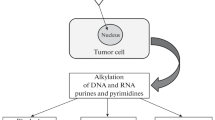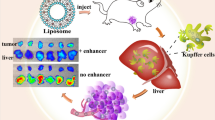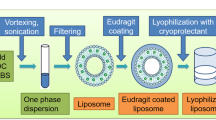Abstract
Purpose: A pharmacological evaluation of an egg phosphatidylcholine/cholesterol (55:45 mole ratio, EPC/Chol) liposome doxorubicin formulation was carried out. The objective was to define liposomal lipid and drug distribution within sites of tumor growth following intravenous (i.v.) administration to female BDF1 mice bearing either Lewis lung carcinoma, B16/BL6 melanoma, or L1210 ascitic tumors. Methods: Mice were injected i.v. with EPC/Chol liposomal doxorubicin, and plasma and tumor levels of lipid and drug were determined 1, 4 and 24 h later with radiolabeled lipid and fluorimetry or fluorescence microscopy, respectively. In addition, single-cell suspensions of the Lewis lung and B16/BL6 tumors were prepared and the presence of macrophages was determined with an FITC-labeled rat antimouse CD11b (MAC-1) antibody. Results: For mice bearing the Lewis lung solid tumors, there was a time-dependent accumulation of liposomal lipid, with a plateau of approximately 500 μg lipid/g tumor at 48 h. In contrast, the apparent plateau (μg doxorubicin/g tumor) for doxorubicin was achieved at 1 h and remained constant over a 72-h time course. In comparison with free drug administered at the maximum tolerated dose (MTD, 20 mg/kg) doxorubicin levels in tumors were two- to threefold greater when the drug was administered in liposomal form. The increase in drug delivery was comparable for both solid tumors. With animals bearing the L1210 ascitic tumor, drug exposure was as much as ten times greater (in comparison with free drug) when doxorubicin was administered in liposomes. An evaluation of single-cell suspensions prepared from the two solid tumors suggested that more than 98% of the tumor-associated drug and liposomal lipid was not tumor cell-associated. Histological studies with the Lewis lung carcinoma, however, revealed that a proportion of the drug did colocalize with tumor-associated macrophages. Analysis of cells obtained from mice bearing ascitic tumors showed that more than 80% of the cell-associated drug could be removed by procedures designed to remove adherent cells. Conclusion: The results summarized here suggest drug concentrations within a solid tumor, such as the Lewis lung carcinoma, are constant over time when the drug is given in a “leaky” EPC/Chol formulation. The results also suggest that liposomal lipid within sites of tumor growth is primarily localized within the interstitial spaces or tumor-associated macrophages.
Similar content being viewed by others
Author information
Authors and Affiliations
Additional information
Received: 23 May 1996 / Accepted: 28 September 1996
Rights and permissions
About this article
Cite this article
Harasym, T., Cullis, P. & Bally, M. Intratumor distribution of doxorubicin following i.v. administration of drug encapsulated in egg phosphatidylcholine/cholesterol liposomes. Cancer Chemother Pharmacol 40, 309–317 (1997). https://doi.org/10.1007/s002800050662
Issue Date:
DOI: https://doi.org/10.1007/s002800050662




